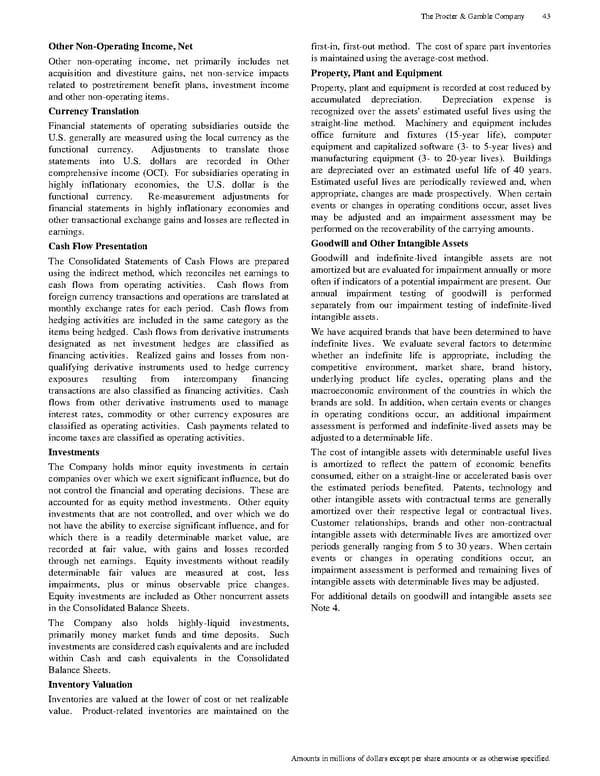Other Non - Operating Income, Net Other non - operating income, net primarily includes net acquisition and divestiture gains, net non - service impacts related to postretirement benefit plans, investment income and other non - operating items. Currency Translation Financial statements of operating subsidiaries outside the U.S. generally are measured using the local currency as the functional currency. Adjustments to translate those statements into U.S. dollars are recorded in Other comprehensive income (OCI). For subsidiaries operating in highly inflationary economies, the U.S. dollar is the functional currency. Re - measurement adjustments for financial statements in highly inflationary economies and other transactional exc hange gains and losses are reflected in earnings. Cash Flow Presentation The Consolidated Statements of Cash Flows are prepared using the indirect method, which reconciles net earnings to cash flows from operating activities. Cash flows from foreign curre ncy transactions and operations are translated at monthly exchange rates for each period. Cash flows from hedging activities are included in the same category as the items being hedged. Cash flows from derivative instruments designated as net investment hedges are classified as financing activities. Realized gains and losses from non - qualifying derivative instruments used to hedge currency exposures resulting from intercompany financing transactions are also classified as financing activities. Cash flow s from other derivative instruments used to manage interest rates, commodity or other currency exposures are classified as operating activities. Cash payments related to income taxes are classified as operating activities. Investments The Company holds minor equity investments in certain companies over which we exert significant influence, but do not control the financial and operating decisions. These are accounted for as equity method investments. Other equity investments that are not controlled, and over which we do not have the ability to exercise significant influence, and for which there is a readily determinable market value, are recorded at fair value, with gains and losses recorded through net earnings. Equity investments without readily deter minable fair values are measured at cost, less impairments, plus or minus observable price changes. Equity investments are included as Other noncurrent assets in the Consolidated Balance Sheets. The Company also holds highly - liquid investments, primarily money market funds and time deposits. Such investments are considered cash equivalents and are included within Cash and cash equivalents in the Consolidated Balance Sheets. Inventory Valuation Inventories are valued at the lower of cost or net realizable value. Product - related inventories are maintained on the first - in, first - out method. The cost of spare part inventories is maintained using the average - cost method. Property, Plant and Equipment Property, plant and equipment is recorded at cost reduced b y accumulated depreciation. Depreciation expense is recognized over the assets' estimated useful lives using the straight - line method. Machinery and equipment includes office furniture and fixtures (15 - year life), computer equipment and capitalized softw are (3 - to 5 - year lives) and manufacturing equipment (3 - to 20 - year lives). Buildings are depreciated over an estimated useful life of 40 years. Estimated useful lives are periodically reviewed and, when appropriate, changes are made prospectively. When certain events or changes in operating conditions occur, asset lives may be adjusted and an impairment assessment may be performed on the recoverability of the carrying amounts. Goodwill and Other Intangible Assets Goodwill and indefinite - lived intangible assets are not amortized but are evaluated for impairment annually or more often if indicators of a potential impairment are present. Our annual impairment testing of goodwill is performed separately from our impairment testing of indefinite - lived intang ible assets. We have acquired brands that have been determined to have indefinite lives. We evaluate several factors to determine whether an indefinite life is appropriate, including the competitive environment, market share, brand history, underlying pr oduct life cycles, operating plans and the macroeconomic environment of the countries in which the brands are sold. In addition, when certain events or changes in operating conditions occur, an additional impairment assessment is performed and indefinite - lived assets may be adjusted to a determinable life. The cost of intangible assets with determinable useful lives is amortized to reflect the pattern of economic benefits consumed, either on a straight - line or accelerated basis over the estimated periods b enefited. Patents, technology and other intangible assets with contractual terms are generally amortized over their respective legal or contractual lives. Customer relationships, brands and other non - contractual intangible assets with determinable lives are amortized over periods generally ranging from 5 to 30 years. When certain events or changes in operating conditions occur, an impairment assessment is performed and remaining lives of intangible assets with determinable lives may be adjusted. For addi tional details on goodwill and intangible assets see Note 4. The Procter & Gamble Company 43 Amounts in millions of dollars except per share amounts or as otherwise specified.
 The Procter & Gamble Annual Report Page 54 Page 56
The Procter & Gamble Annual Report Page 54 Page 56